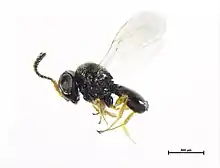Trissolcus basalis
Trissolcus basalis, or the green vegetable bug egg parasitoid, is a parasitoid wasp in the family Platygastridae known primarily for parasitising the horticultural pest Nezara viridula, the green vegetable bug.[1]
| Trissolcus basalis | |
|---|---|
 | |
| Lateral view of female T. basalis. | |
| Scientific classification | |
| Kingdom: | |
| Phylum: | |
| Class: | |
| Order: | |
| Family: | |
| Genus: | |
| Species: | T. basalis |
| Binomial name | |
| Trissolcus basalis (Wollaston, 1858) | |
| Synonyms | |
| |
Description
Like other species of Trissolcus, T. basalis is small (around 2mm long), mostly black in colour, and females have clubbed antennae.[2]Trissolcus basalis can be separated from other nearctic Trissolcus species by the presence of coriaceous microsculpture on the mesoscutellum, pustulate setal bases, shallowly impressed episternal foveae on the mesopleuron, and an incomplete netrion sulcus.[3]
Life cycle
Trissolcus basalis is a solitary endoparasitoid, completing development within the eggs of pentatomid bugs.[4] Females use their clubbed-shape antennae to palpate eggs laid by their primary host, Nezara viridula. When ready to oviposit, the female faces away from the egg and backs into it, inserting her ovipositor through the wall of the egg. Once finished ovipositing, the female withdraws her ovipositor and wipes the tip across the egg surface to mark the egg. After adults have completed development, males emerge first followed by females a couple of days later. Males mate with females as they emerge from the egg.
Ecology
In New Zealand, T. basalis has been recorded from non-target hosts including Cermatulus nasalis (Woodward, 1837), Cuspicona simplex Walker, 1867, Green potato bug, Dictyotus caenosus (Westwood, 1837), Glaucias amyoti (Dallas, 1851), Monteithiella humeralis (Walker, 1868), and Oechalia schellenbergii (Guerin, 1831).[5] It has no known natural enemies in New Zealand, although Acroclisoides, a genus containing a species known to hyperparasitise T. basalis in Australia, is known to be present in New Zealand.[6]
Distribution
Trissolcus basalis is considered to be an effective biocontrol agent in New Zealand, Australia, and the United States, all places where it was deliberately introduced.[2] In 1949 T. baslis was released in New Zealand in an effort to control damage caused to crops including sweet corn and green beans by Nezara viridula.[5] Over 48,000 parasitoids were reared from a shipment of between 200 and 300, and these were released at Awanui, Kaitaia, Paihia, Kawakawa, Whangarei, New Plymouth and Te Kaha (Bay of Plenty).[7]
References
- Powell, Janine E.; Shepard, Merle (1982). "Biology of Australian and United States strains of Trissolcus basalis, a parasitoid of the green vegetable bug, Nezara viridula". Australian Journal of Ecology. 7: 181–186. doi:10.1111/j.1442-9993.1982.tb01591.x.
- "Trissolcus basalis". Cornell University College of Agriculture and Life Sciences. Retrieved 7 February 2019.
- Buffington, Matthew; Johnson, Norman F.; Talamas, Elijah J. (2015-03-27). "Key to Nearctic species of Trissolcus Ashmead (Hymenoptera, Scelionidae), natural enemies of native and invasive stink bugs (Hemiptera, Pentatomidae)". Journal of Hymenoptera Research. 43: 45–110. doi:10.3897/JHR.43.8560. ISSN 1314-2607.
- Wilson, F. (1961). "Adult reproductive behaviour in Asolcus basalis (Hymenoptera: Scelionidae)". Australian Journal of Zoology. 9 (5): 739–751. doi:10.1071/zo9610739. ISSN 1446-5698.
- Martin, Nicholas. "Green vegetable bug egg parasitoid - Trissolcus basalis". Interesting Insects and other Invertebrates: New Zealand Arthropod Factsheet Series.
- Saunders, Tom (March 2018). "Acroclisoides observed in Auckland". iNaturalistNZ.
- Cumber, R. A. (1950). "The introduction into New Zealand of Microphanurus basalis Woll. (Scelionidae: Hym.), egg parasite of the green vegetable bug, Nezara viridula L. (Pentatomidae)". The New Zealand Journal of Science and Technoloy, Section B. 32:5: 30–37.